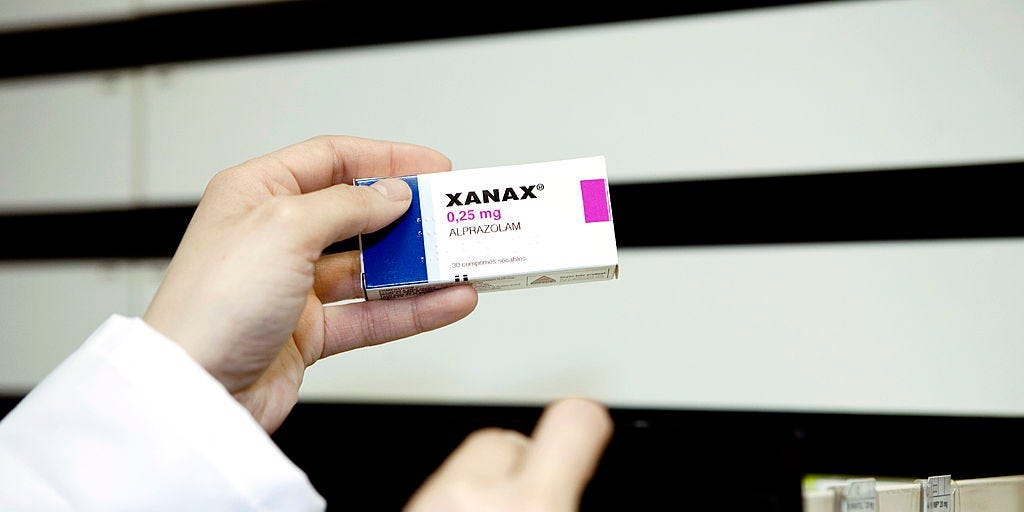- Xanax kicks in after about 15 minutes and peaks after 1-2 hours from ingestion.
- Xanax's half life is 11 hours, but you'll typically stop feeling its effects after 6 hours.
- Xanax can be detected in a person's system via urinalysis from 2-4 days after ingestion.
- Visit Insider's Health Reference library for more advice.
Alprazolam, available under the brand name Xanax, is a prescription medication in the benzodiazepine class commonly used to treat anxiety and panic disorders. It is also sometimes prescribed for depression, premenstrual syndrome, and insomnia.
It works by slowing down the activity of the neurons in the brain, which produces a calming effect. How long this calming effect lasts largely depends on biological factors like age, weight, metabolism, and liver function, as well as your history with the medication including dosage, how long you've been taking it, and how often, among other factors.
The half life of Xanax is 11 hours, but you're likely to lose its effects much sooner than that.
When does Xanax kick in?
The calming effects of Xanax can be felt within 15 minutes or so and typically reaches its peak about one to two hours after ingestion. You can take Xanax with or without food and an empty stomach won't affect how quickly it kicks in, says Mark Loafman, MD, MPH, a family physician at Cook County Health.
Before taking Xanax, check the expiration date first. The Food and Drug Administration (FDA) advises against the use of expired medications because there's no assurance that they will be safe and effective after the expiration date.
"The [expired] medication might be less effective. If it is less effective, in the case of Xanax, a person might experience anxiety that is much greater as it is not as well-controlled, but they also might go into withdrawal," says Douglas Misquitta, MD, a psychiatrist at The Ohio State University Wexner Medical Center.
How long does Xanax stay in your system?
On average, Xanax can be detected in a person's system via a urine test, aka urinalysis, for two to four days after ingestion.
The average half-life of Xanax — or the time it takes the body to eliminate half of the amount of the drug — is about 11 hours in healthy adults. However, you'll likely only feel the effects for roughly six hours, says Loafman.
How long a medication stays in your system is different from how long you'd feel its effects, says Misquitta. The body breaks down the medication as time goes by, therefore the effects will not be as strong even though it remains in the system.
That's why people often take Xanax multiple times throughout the day. For example, the average adult typically takes 0.25 mg to 0.5 mg of Xanax three times a day for anxiety.
Because alprazolam is broken down and eliminated in the liver, the half-life and how long you feel the effects may be longer for people with abnormal liver function, says Loafman. Factors that affect liver function include the following:
- Older age
- Obesity
- Routine or heavy alcohol use
- Underlying liver disease
In case you missed a dose, take it as soon as you remember. However, if it's closer to your next dose, skip the missed dose and just continue the regular dosing schedule. Don't take two doses to compensate.
Xanax and alcohol interaction
Xanax and alcohol are both central nervous system depressants, which means they slow down brain activity. Taking them together can increase the risk of serious, life-threatening side effects such as:
- Unusual dizziness
- Extreme sleepiness
- Slowed or difficult breathing
- Unresponsiveness
In fact, mixing Xanax and alcohol can cause sedation so deep that, "one could pass out, stop breathing, or vomit in their sleep without waking up to protect the airway," says Loafman.
That's why it's important to wait until most, or all, of Xanax is out of your system before drinking alcohol.
"Alcohol should not be used until well after the half-life for alprazolam to be broken down, or about 18 to 24 hours in those with normal metabolism. For those who are likely to metabolize slower, wait the full 24 hours," says Loafman.
Anyone with a form of liver disease and taking Xanax should avoid alcohol altogether, he adds.
Symptoms of Xanax withdrawal
"People can become physically dependent on medications such as Xanax, such that when it begins to leave their system, they can feel sick," says Misquitta.
You may become dependent after taking Xanax for several days to several weeks. That's why you should never stop taking Xanax or reduce your dose without consulting your doctor beforehand.
If you've become dependent on Xanax and suddenly stop taking it, symptoms will start within a few hours of missing a regular dose, says Loafman. They can last anywhere from several weeks to more than a year.
Withdrawal symptoms include the following:
- Anxiety
- Depression
- Memory problems
- Insomnia
- Shaking or trembling
- Difficulty concentrating
- Seizures
- Confusion or paranoia
- Changes in mental health
- Thoughts of self-harm
Misquitta and Loafman say Xanax withdrawal can be life-threatening, therefore it's crucial to receive treatment immediately if you start to experience symptoms.
Insider's takeaway
The half-life of Xanax is about 11 hours, but you're likely to lose the calming effects within about 6 hours of taking it.
Avoid alcohol while Xanax is still in your system because it can cause serious side effects such as dizziness and unresponsiveness.
If you've developed a dependency on Xanax and you're experiencing symptoms of withdrawal, such as anxiety, insomnia, or seizures, talk to your prescribing provider immediately about treatment.
